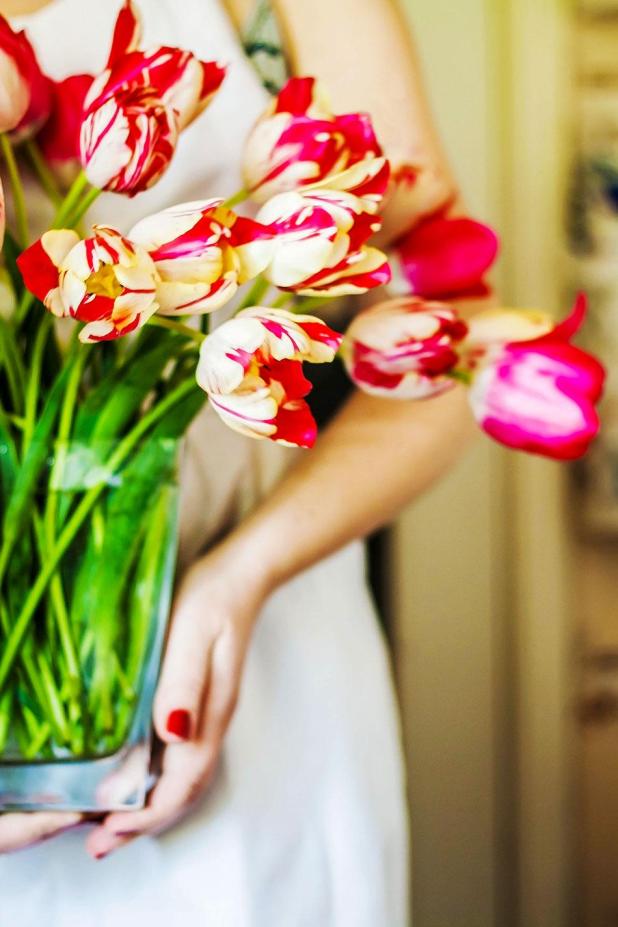
Bulbs can be forced to bloom by providing the environmental conditions to encourage growth. Tulips are some of the earliest spring-blooming bulbs that can be forced early.
Forcing bulbs for indoor winter flowers
The late winter months may lack color in the landscape, but with proper planning and a little effort, you can create an early spring indoors or make a beautiful gift by forcing your own succession of hardy bulbs.
Bulbs are perennial plants that overwinter as fleshy, underground structures. These types of plant structures gather carbohydrates from the leaves during photosynthesis and are stored as nutrients for future growth.
There are many plant types that use this specialized energy storage. Loosely grouped in with bulbs are corms such as crocus and gladiolus, tubers such as caladiums and Irish potatoes, tuberous roots such as dahlias and sweet potatoes, and rhizomes such as irises and cannas.
True bulbs are compressed, underground stems (basal plate) with a modified flower bud surrounded by modified fleshy leaves called scales. Two of the best-known examples of true bulbs are onions and garlic. When thinking of flowering bulbs, the most commonly known are tulips, daffodils, hyacinths, lilies, Dutch iris, paper whites and amaryllises.
Bulbs can be planted from mid-September to December, depending on the desired flowering date and the length of storage required. In general, early-spring bloomers need eight to 12 weeks of chill time in 30 to 35 degrees Fahrenheit. Mid-spring bloomers require 12 to 14 weeks of chill time, and late-spring bloomers need 16 weeks on average.
A refrigerator is the perfect place to chill bulbs, as it will maintain the necessary temperatures at a steady rate for the required period. Crisper drawers are often used.
It is fun to trick spring-flowering bulbs into blooming indoors. We can encourage many bulb types to bloom early by providing the correct environmental conditions and chilling temperatures.
Force bulbs by placing them in dark, cool locations. They can be forced bare or in soil planted in containers and placed in refrigerators. Some can be chilled and then placed in bulb vases that provide support needed for growth and develop roots and shoots.
Some of the most common hardy bulbs used for forcing are crocuses, daffodils, hyacinths and tulips. Some others are dwarf iris (Iris reticulata), Dutch Iris (Iris x hollandica), grape hyacinth (Muscari spp.), glory of the snow (Chionodoxa luciliae), snowdrop (Galanthus nivalis) and summer snowflake (Leucojum aestivum).
Chilling is the most important part of successful bulb forcing. All bulbs except amaryllis need a cold period before they will bloom. Because they are native to the tropics, amaryllis bulbs do not require a chilling period.
Amaryllis takes six to eight weeks to bloom once planted, and paper whites take three to five weeks once planted. If you wish to give either as holiday gifts, start them now!
Once the chilling period has been reached, it takes about two to three weeks for the stem to elongate and blooms to open.
Crocus and grape hyacinth takes eight to 15 weeks of chilling. Daffodils, hyacinth and iris reticulate take 13 to 15 weeks. Tulips take 10 to 16 weeks, and snowdrops take 15 weeks.
In general, for blooms in January, bulbs should be chilled in September. For blooms in February, chill in October, and so on.
At the end of the cooling period, check the pots for roots protruding from the drainage holes. This signals they are ready. Bring the bulbs out of cold storage at this point and transfer to a cool room of 60 to 65 degrees. Higher temperatures will speed up the process of growth and flowering. Lower temperatures encourage compact growth.
Pot deep enough for there to be a couple of inches of soil below the bulbs, and cover up to the bulb necks. You can pack as many bulbs as the media will allow and crowd them. If you are looking to grow for cut flowers, force them in flats. Be sure all the bulbs require the same amount of cooling period.
Once planted, be sure to keep the soil damp, not wet. You can “wake” the bulbs by giving them a few weeks of warmer temperatures and indirect sunlight. Once the bulbs shoot up and are a couple inches tall, give them more sun and a warmer spot. This will bring the bulbs into bloom.
Pro tips: You can prolong the bloom period by moving pots into indirect light and place them in a cool area at night or in the refrigerator. In addition, to keep stems straight, rotate the pots regularly. You can also buy bulbs that have already been chilled.
